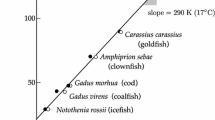Abstract
The values of the rate constants and the associated enthalpies and entropies of enzymes with two catalytic steps can be measured by determining the effects of temperature on the k cat values. Practical considerations that should be taken into account when doing this are presented. The narrow temperature range available with enzymes and the sensitivity of pH to temperature mean that special attention to detail must be taken and this study highlights the assiduousness needed. The necessity of conversion of apparent k cat to true k cat values when assays are done with products having pKa values near to the assay pH is shown and the importance of obtaining sufficient data is emphasized. Reasons that non-linear regression should be used to obtain the estimates of rate constants and activation thermodynamic parameters are given. Other precautions and recommendations are also presented. Results obtained by this method for native β-galactosidase (E. coli) and for a β-galactosidase in which a Thr was substituted for Asn-460 were analyzed to demonstrate the valuable mechanistic details of enzymes that can be obtained from studies of this type.






Similar content being viewed by others
Notes
If there were a large (~100-fold) difference in ∆H ‡2 and ∆H ‡3 , the transition from k 3 to k 2 being rate limiting would be distinct with a definite break in an Arrhenius plot rather than a curve. The lines would be linear on each side of the break. Thus, linear regression could be applied at the two sides of the break where k 2 and k 3 are definitely rate limiting. Such big differences in activation enthalpy between two catalytic steps are, however, unlikely with enzymes. Note that distinct breaks would also be seen for an enzyme with only one catalytic step if that enzyme undergoes a clear-cut temperature dependent conformation change that affects activity [14] and one must be careful in interpreting such graphs.
A study of the temperature effects on β-galactosidase in the presence and absence of monovalent cations was included in an earlier study done in our laboratory [15]. It was not done as rigorously as the present study and the enzyme has low heat stability in the absence of monovalent cation but it showed that when no monovalent cation was present the entropy of k 2 for oNPG was decreased while the enthalpy was not changed significantly.
The B-factors of d-galactonolactone (relative to the average B factors for the whole enzyme) are larger for N460T-ß-galactosidase than for native. In particular, the average B factors for C2 and O2 of the d-galactonolactone bound to N460T-β-galactosidase are 32 and 38% greater, respectively, than for native (relative to the average B-factor values of the whole proteins).
Abbreviations
- Amp:
-
Ampicillin
- BSA:
-
Bovine serum albumin
- EDTA:
-
Ethylene diamine tetraacetic acid
- LB:
-
Luria–Bertini
- Onp:
-
o-Nitrophenol
- oNPG:
-
o-Nitrophenyl-β-d-galactopyranoside
- Pnp:
-
p-Nitrophenol
- pNPG:
-
p-Nitrophenyl-β-d-galactopyranoside
- TES:
-
N-Tris(hydroxymethyl) methyl-2-aminoethane-sulfonic acid
References
Ayala YM, Di Cera E (2000) Prot Sci 9:1589–1593
Cornish-Bowden A (2002) J Biosci 27:121–126
Gebler JC, Aebersold R, Withers SG (1992) J Biol Chem 267:11126–11130
Huber RE, Brockbank RL (1987) Biochemistry 26:1526–1531
Juers DH, Heightman TD, Vasella A, McCarter JD, Mackenzie L, Withers SG, Matthews BW (2001) Biochemistry 40:14781–14794
Stokes TM, Wilson IB (1972) Biochemistry 11:1061–1064
Motulsky HJ, Christopoulos A (2003) www.graphpad.com, GraphPad Software Inc.
Allan GF, Robinson RA, Bower VE (1962) J Phys Chem 66:171–172
Robinson RA, Peiperl A (1963) J Phys Chem 67:1723–1724
Motulsky HJ, Ransnas LA (1987) FASEB J 1:365–374
Huber RE, Gaunt MT, Hurlburt KL (1984) Arch Biochem Biophys 234:151
McCarter JD, Adam MJ, Withers SG (1992) Biochem J 286:721–727
Huber RE, Hurlburt KL (1986) Arch Biochem Biophys 246:411–418
Weingand-Ziade A, Renault F, Masson P (1999) Eur J Biochem 264:327–335
Xu J, McRae MA, Harron S, Rob B, Huber RE (2004) Biochem Cell Biol 82:275–284
Author information
Authors and Affiliations
Corresponding author
Rights and permissions
About this article
Cite this article
Kappelhoff, J.C., Liu, S.Y.J., Dugdale, M.L. et al. Practical Considerations When Using Temperature to Obtain Rate Constants and Activation Thermodynamics of Enzymes with Two Catalytic Steps: Native and N460T-β-Galactosidase (E. coli) as Examples. Protein J 28, 96–103 (2009). https://doi.org/10.1007/s10930-009-9168-1
Published:
Issue Date:
DOI: https://doi.org/10.1007/s10930-009-9168-1




